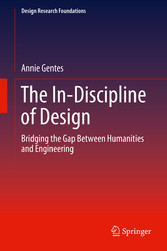The In-Discipline of Design - Bridging the Gap Between Humanities and Engineering
von: Annie Gentes
Springer-Verlag, 2017
ISBN: 9783319659848
, 247 Seiten
Format: PDF
Kopierschutz: Wasserzeichen
Preis: 85,59 EUR
eBook anfordern 
Mehr zum Inhalt

The In-Discipline of Design - Bridging the Gap Between Humanities and Engineering
Design is a conceptive activity which is usually presented as a sensible, sequential process and action. This book claims that design cannot be reduced to the rational, effective planning and organization that most models (such as design thinking) present. The author suggests another type of rationality which is based on what the humanities call aesthetics, writing, composition, and style: a rationality based in imaginary elaboration and coherence. The chapters, therefore, demonstrate that design practice is about creating not only functional tools, but planes of reflections that challenge norms.
To support this claim, this book analyzes research programs, art works, and design projects that produced new information and communication technologies (ICT). This is detailed using examples in each chapter. From these examples, two types of conclusions are derived: a first level considers the lessons that we can draw from these examples in terms of design practice while the second level starts a theoretical discussion based on these analyses of use cases.
The goal is to develop an understanding of conception in its different forms. This book brings the use of these neglected methods to the foreground as a way to explicate the design process. Taking into consideration the humanities within design contributes to the discussion on pluridisciplinarity. The book posits that design as a historical and situated activity is a truly multidisciplinary endeavor that bridges the gap between engineering sciences and the humanities.
Annie Gentes is associate professor in Information and Communication Sciences at the school of engineering Telecom ParisTech and Head of the Codesign Lab. Her research focuses on contemporary forms of design that emerge in scientific research and society. She analyzes practices such as critical design, ludic design, or universal design to understand their contributions to a theory of design. In particular, she addresses the place of humanities in design activities from an epistemological point of view. She works with artists, designers and engineering scientists to understand both what is common and what is specific in their conceptive activities.











